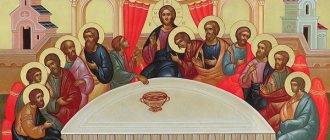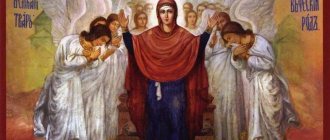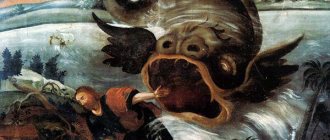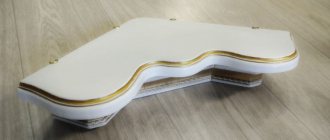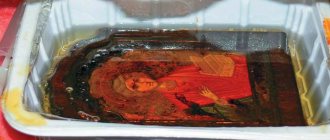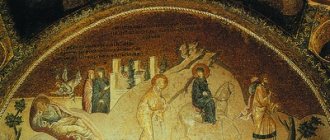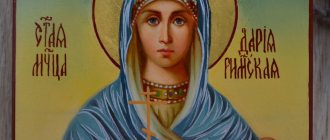For thousands of years, the icon has accompanied a believer on his life's path. Today, some icons are recognized as a unique cultural object. But at the same time, absolutely any holy image, regardless of the type and technique of execution, is deeply revered by religious people.
In a Christian's home, the icon is usually given a special place - a prayer corner, which is usually called the “red corner”. Today, icons can be placed on beautiful carved shelves, in an icon case or in an iconostasis.
We wrote more about how and where to place icons in the house here.
As for the icons themselves, there are a huge number of them. Moreover, each can be classified according to certain characteristics and assigned to a certain type.
What is similar and what is different between an icon and a painting?
An icon, like a painting, is a subject of human artistic creativity. Like painting a picture, painting an icon requires the use of certain artistic methods and techniques, artistic skill.
Meanwhile, the icon differs from the painting in essence. First of all, it should be noted that the icon represents a special sphere of human existence - spiritual and religious, has special functions, a special purpose.
A picture can depict both a real and a fictional, imaginary world. An icon is only real, but unlike a painting, it shows it not from the point of view of the painter, but based on the Revelation of God.
The world displayed on the icon is not only, and not even so much the world of earthly existence familiar to sinners, but rather a world of other existence. Representing even the earthly, visible, sensory world, the icon reveals it as it is seen by the saints: as an object of God’s Creation and Care; as an arena of spiritual struggle between the forces of Good and Evil. At the same time, icons represent to us both the world above and the world below.
Even if we are talking about religious paintings, which can display ideas inherent in Orthodox iconography, these paintings, being independent of the requirements of church canons, bear the stamp of individualism of their authors, the trace of a private, subjective worldview and the author’s errors, fantasies associated with this particularity, dreams (in this regard, the difference between icons and paintings can be compared with the difference that can be traced between church and extra-church religious and philosophical literature).
The purpose of the icon is to promote the unity of man and God. Of course, to some extent, a painting can also serve this purpose, for example, by having a beneficial effect on aesthetic and even religious feelings and thereby contributing to the moral transformation of the individual. However, this does not apply to all examples of painting. Quite often, paintings, even those belonging to the field of high creativity, arouse in a person those feelings with which the concept of Christian virtue and purity is absolutely not reconciled.
Unlike paintings, which reflect reality with varying degrees of concreteness, an icon is deeply symbolic; Moreover, as a rule, these symbols are understandable and accessible to all attentive, educated believers. The images of symbolic paintings are often understandable only to their authors.
Finally, the icon serves as a window into the heavenly world. Reverently looking at the image of God or His saint, marked on the icon, the Christian spiritually ascends to the Archetype itself; praying before the face of the person depicted, he is actually united by a spiritual connection with the person depicted Himself, God or His saint; and God, or His saint, really hears the prayer, really answers the request of the one praying (to the extent of faith and to the extent of appropriateness).
The painting has no such meaning or purpose. Moreover, a false picture depiction of God contributes to the formation of a false impression of Him in the gullible viewer, which can lead to the creation of some kind of imaginary idol in the soul.
Iconostasis at home
Since ancient times, there has been a tradition of creating an iconostasis at home. The first thing they did when entering a new house was to take an icon with them in order to protect its walls from evil and evil spirits. Sometimes their number was greater than in a small church, so the believers tried to protect themselves from troubles. It was believed that there should be three main icons in the apartment: the Savior, the Mother of God and St. Nicholas the Wonderworker. And as life progressed, they were supplemented with wedding, holiday, and images of patron saints.
On the day of baptism, everyone has their own intercessor, whose name he bears. In honor of such an event, it is customary to give measured icons. Of course, we are talking more about children here. It was believed that she could protect and protect her owner throughout her life if she turned to her with prayer and pure thoughts.
There are such concepts as ancestral and family icons. They are different in meaning and spelling. The first is passed down from generation to generation and can be very ancient. And the second contains images of saints of all family members, and in the center - the most revered saint.
How is an icon different from an idol?
Initially, man was not an unbeliever. Before the Fall, primordial people vividly sensed the presence of God and were in communion with Him. This relationship was destroyed as a result of a daring crime. At first, knowledge about the True God, the Creator, spread among descendants from fathers and mothers to children. Gradually, true knowledge about God was replaced by false knowledge and became overgrown with myths and legends.
Eventually, perverted beliefs in local gods spread among the peoples. In an effort to have tangible images of fictional deities at hand, people began to create idols for themselves. Often the idols themselves were “endowed” with supernatural, divine properties. Therefore, idols appeared as a result of ignorance of God, as one of the results of sin.
Idol translated from Greek means image. It is a statue, an idol, which is worshiped as a deity. For a pagan, the idol he worshiped was, as it were, a living, physical embodiment of the deity. To bring a bloody sacrifice to an idol, to offer a treat in the form of some fruits or flowers meant literally “to feed, to appease the deity.” The pagan consciousness perceived a man-made idol as a visualized deity, which materialized in wood, metal, marble or any other material from which the idol was made.
Unlike idols, holy icons do not personify a deified creature or imaginary false gods. They represent images of the One and True God incarnate, as well as images of His saints, images of the visible and invisible world, important events of the past, present, and future.
Unlike idolaters, who believed in the power of their idols, Christians, when they venerate icons and pray in front of them, do not mean that prayer requests are directed to wood and paints. The Orthodox treat icons as shrines, godly means that promote unity with the Lord, good angels, and the righteous, but do not endow them with Divine qualities.
Despite the fact that idols themselves do not possess any supernatural power, their worship can be accompanied by the manifestation of otherworldly forces. Why? Idolatry pleases the devil; By worshiping idols and graven images, people enter into communication with demons (1 Cor. 10:19–20).
Icon veneration is a completely different matter. The practice of venerating holy icons is pleasing to God. One of the first representative images of Christ was created at the direction of God back in the days of the Old Testament. We are talking about a copper serpent: “ And the Lord said to Moses: make yourself a [copper] serpent and display it on a banner, and [if the serpent bites any person], the one who is bitten, looking at it, will live.”
"(Num. 21:8). The copper serpent prefigured Christ, ascended to the Cross, died and rose again, looking at Whom with faith Christians are delivered from the power of the devil and sin.
Idols are powerless. And through the prayers of true believers, praying in front of icons, God teaches grace. The icon helps the pilgrim to rise in spirit to the prototype whose image is presented on it. Therefore, looking at the image, a Christian enters into communication not with the image, but with the depicted saint. And despite the fact that the person praying faces the image, his prayer is actually, and not imaginary, heard by the prototype itself. In this regard, the icon is often designated as a window into the heavenly world.
Worship of idols corrupts the morals of people. Humble and repentant prayer in front of icons contributes to climbing the ladder of spiritual perfection.
Those who worship idols can be subjected to the judgment of God's Truth already in earthly life, but what is much more terrible is that they put themselves in danger of eternal destruction (Deut. 27:15). Those who venerate holy icons often become objects of God's mercy and God's blessings.
Healing images
For the majority of those who are often or seriously ill, an icon is an opportunity to ask for help. And there are those whom it is customary to turn to in difficult times. Many believers know Panteleimon the healer and the Great Martyr Barbara, the wonderworkers Damian and Cosmas. When turning to the image of the Mother of God - the “Inexhaustible Chalice” icon - they pray for deliverance from addictions (drug addiction, alcoholism, smoking). The history of its origin dates back to 1878. An old soldier arrived from the Tula province to the Serpukhov convent with the goal of finding this icon and being healed. He suffered from heavy drinking and for this reason lost the ability to walk. A recurring dream brought him to this monastery, in which he saw an old man who ordered him to appear in this very place for healing.
He had to crawl 100 km from his house to Serpukhov. The Lady had mercy on him and directed him to the old woman’s house. The soldier stayed with her for two days, during which time the old woman helped him get a little stronger, smeared his legs with healing ointment, and then he walked further, leaning on a crutch. When he reached the monastery and told about his difficult journey to Serpukhov, he asked to be directed to the icon of the “Inexhaustible Chalice,” but no one knew about it. Hearing that the Mother of God herself was helping him, people went to look for her. The soldier went to the relics of the Monk Varlaam, who founded the monastery, and recognized him as the old man from his dream.
Meanwhile, in the corridor that connected the sacristy with St. George's Church, they discovered an old icon painted in the Byzantine style. The board depicted the Mother of God, and in front of her was the baby Jesus in a bowl. Turning the image back, the monastery servants saw the inscription: “The Inexhaustible Chalice.” She was immediately taken to the church and a prayer service was served, during which the soldier felt relief and left the walls of the monastery already healthy, and he no longer had the desire to drink alcohol.
Why consecrate icons?
The meaning of the consecration of icons is expressed in the prayer that the priest reads during the consecration of the icon: “Look at these icons that Your servants created in Your honor and glory <...>, bless and consecrate them, and give them healing power, driving away all the snares of the devil, and make sure that everyone who prays diligently before them is heard, and finds the mercy of Your love for mankind, and receives grace.”
According to S.V. Alekseev, “consecration is, one might say, a blessing that is given on behalf of the entire Church by a clergyman for the use of an object or image for Communion with God. In relation to holy icons, consecration is also a criterion for assessing their theological content and, accordingly, permission to participate in the liturgical life of the Church. Icons that are questionable in content and execution technique do not receive blessings.
We will not judge whether changes occur in the physical nature of the object at the moment of its consecration, but from a moral point of view, these changes are obvious. Not only the status of an object changes, but also a person’s attitude towards it.”
Nicholas the Wonderworker, protector of travelers
Those whose lives involve constant movement and business trips often ask for intercession before the icon of St. Nicholas the Wonderworker. Its miraculous power has been known for centuries. Nicholas lived back in the 3rd-4th century, he was a merciful and pious bishop of the city of Myra in Lycia. During the years of his life, there were already legends about him; he could heal, save innocents from death, and calm bad weather. According to church tradition, the saint’s relics, preserved incorrupt, exuded myrrh, which helped many to be healed.
One of the miracles after his death happened in 1812, when during Napoleon’s retreat from Moscow the Nikolskaya Tower on the Moscow Kremlin exploded. An icon was placed above its gates, the name of which the foreigners did not know, and they also did not know about its power. The walls tilted at the moment of the explosion, but stood firm; doors and windows were knocked out. Not only the image remained intact, but also the glass that covered it.
All sailors and travelers turn to Saint Nicholas, knowing that he will ask the Almighty for help and intercession during a long journey.
Who painted the very first icon and when?
According to Church Tradition, the first icon appeared during the earthly life of the Savior. This is the image that we know as “The Savior Not Made by Hands.” A detailed account of the origin of the Image Not Made by Hands is found in the Chetya Menaion. Briefly, it boils down to the following: King Abgar of Edessa, suffering from leprosy, sent his archivist Hannan (Ananias) to Christ with a letter in which he asked Christ to come to Edessa and heal him. Hannan was an artist, and Abgar instructed him, if the Savior could not come, to paint His image and bring it to him. Hannan found Christ surrounded by a dense crowd; he stood on a stone from which he could see better and tried to portray the Savior. Seeing that Hannan wanted to make His portrait, Christ asked for water, washed himself, wiped His Face with a cloth, and His image was imprinted on this cloth. The Savior handed this board to Hannan with the command to take it with a reply letter to the one who sent it. In this letter, Christ refused to go to Edessa Himself, saying that He must fulfill what He was sent to do. Upon completion of His work, He promised to send one of His disciples to Abgar. Having received the portrait, Avgar was healed of his main illness, but his face remained damaged. After Pentecost, the holy Apostle Thaddeus, one of the 70, went to Edessa, completed the healing of Abgar and converted him to Christianity. Abgar attached the image to the board and placed it in a niche above the city gate, removing the idol that was there.
"Saving amulets"
Today, in the Christian religion, a fairly profitable business is the sale of amulets and charms that will cure all ailments, protect from all troubles, and bring health, success, and love. They will help single people find their match, and married people will help them save their family. Truly almighty little things!
Among Muslims, such amulets are not only not allowed, but are also strictly prohibited, especially those that supposedly protect against damage, the evil eye, illnesses and misfortunes. Wearing amulets in Islam is considered worship of several gods. But a person must turn to Allah exclusively for help.
Comments
Are all icons miraculous?
Church history knows many miracles occurring through holy icons, from ancient times to the present day. Moreover, in the Church there are many revealed images (that is, miraculously acquired through the Providence of God), and their appearance is marked by miracles. But the line between a miraculous and a non-miraculous icon is not absolute and not fundamental. Each icon is blessed and can become miraculous. One can even say that every icon in front of which one fervently and sincerely prays to God, holy or incorporeal forces, becomes miraculous for those praying, since before this image a miracle of soul transformation takes place.
What icons are placed in the center of the temple on the lectern?
In the center of the temple, on a lectern, there is placed an icon of the holiday (if there is any church holiday on this day) or an icon with the image of a saint whose memory is celebrated on this day. On Sunday, an icon of the Resurrection of Christ is placed; in addition to it, an icon of a holiday or saint can also be placed. On other days, the temple icon lies on the lectern, that is, the icon of the holiday or saint in whose honor the main altar of the temple was consecrated.
How to kiss icons correctly?
You should approach the icons slowly, mentally saying a prayer. It is customary to cross yourself twice with a bow from the waist, then venerate the icon as a sign of love and reverence for what is depicted on it. After this, cross yourself a third time, bow and move away. You should kiss the feet of the Savior depicted on the icon, the blessing right hand (right hand), and the hem of his clothing. The Mother of God and the saints have a hand or the edge of their clothing, and the miraculous image of the Savior and the head of John the Baptist are in their hair. If there is an icon in front of you that a large number of people besides you want to venerate, pray in advance so as not to delay or tempt other believers.
Wedding couple
Those who have decided on the sacrament of wedding need to know that there is a certain set of icons that should be present when performing the sacrament. This is the image of the Mother of God (in the hands of the bride) and the Savior (in the hands of the groom). They are very symbolic and during the wedding they mean that the man takes on the role of the cross of family life, the so-called small church; the woman becomes a guardian and protector, bringing fidelity, goodness and the greatest maternal love.
It is customary to place them in a house on the eastern side: on the right side is the image of Christ, on the left - the Virgin Mary. In the old days, wedding icons were passed on as blessings from parents to children.
Why are lamps lit in front of icons and censing performed in front of them?
The lamps symbolize spiritual joy, warmth of faith and burning spirit of those praying in front of the icons. God Himself commanded the prophet Moses to light lamps in front of sacred images and burn incense in front of them: “And command the children of Israel to bring you pure oil, beaten from olive trees, for illumination, so that the lamp will burn at all times; in the tabernacle of meeting, outside the veil, which is before the ark of the testimony, Aaron and his sons will light it from evening until morning, before the Lord. This is an everlasting statute for their generations from the children of Israel” (Ex. 27:20-21). During Orthodox services, lamps are lit as a sign of the joyful burning of the spirit before God, and fragrant incense is burned to remind believers that prayer, like incense smoke, must rise upward to the Throne of God.
How to arrange a home iconostasis?
You should definitely have icons of the Savior and the Mother of God at home. In addition, there are many icons of saints of God. It is good to have in your home iconostasis icons of saints whose names are borne by family members and those saints whose heavenly help they most often turn to. It is better to purchase icons in an Orthodox church or in special church stores, where they have already been consecrated. Icons should be placed in a holy corner or home iconostasis according to the principle of hierarchy. The main place should be allocated to the icons of the Most Holy Trinity, the Lord Jesus Christ and the Most Holy Theotokos. It is desirable that the icon of the Trinity and Christ be no less than the other icons. The icon of the Most Holy Theotokos, as a rule, is placed next to the image of the Savior, at His right hand (that is, to the right, on the right hand). The remaining icons are located on either side of them, depicting the assembly of saints around the Lord Jesus Christ. The holy cross must be placed in a prominent place as a symbol of saving people from eternal death.
The meaning of saints in Orthodoxy
Saints in Orthodoxy are needed in order to turn to them in moments of sorrow or despair, when there is no way to solve the problem on your own. They are often consulted for incurable illnesses or problems at home. Girls may ask about finding a lover or about the possibility of conceiving a child.
Icons are placed in shrines: churches, chapels, monasteries. The saints served as patrons of the sacred place, as well as the city that is located closest to the image. Also, each icon shows a different type of scripture, which indicates the development of iconography.
Where to arrange a home iconostasis?
For a home iconostasis, it is advisable to specifically allocate a part of the main room (or a place in each room); according to the ancient Russian tradition, the front corner was chosen, that is, at the entrance to the room, the front corner on the right, which could often coincide with the east. In this so-called red corner, a place is created exclusively for icons, lamps, holy water, prosphora and other shrines. It is possible, if conditions do not allow, to arrange a place for icons and not in the corner of the room, the main thing is to create a kind of home iconostasis, which will become a convenient place for personal and family prayer. It is advisable to avoid close proximity to the iconostasis of a TV, tape recorder and other household appliances, which all serve earthly, momentary purposes. You should not place decorative objects of a secular nature next to holy icons.
What are the main types of iconography of the Savior?
The iconography of the Lord Jesus Christ includes many areas, including those associated with the Festive cycle (however, the iconography of the Holidays is usually considered as an independent direction of icon painting).
The main iconographic types of the Savior are most often identified as five: the Savior Not Made by Hands, the Lord Almighty (Pantocrator), the Savior in Power, the Savior Emanuel (Emmanuel), the Savior on the Throne.
Savior Not Made by Hands
According to Church Tradition, icons of this type reproduce the lifetime image of Christ, revealed as a result of a miracle.
History connects this miracle with the following events. When the Edessa king Abgar, who suffered from an incurable disease (leprosy), learned about the miracles performed by Christ, he sent his painter, Ananias, to Him, so that he would hand Him a letter inviting him to visit the city of Edessa. After listening to Ananias, Christ refused Abgar a personal visit, but did not refuse His mercy. Having washed his face and demanded that ubrus (cloth) be brought, Christ wiped himself off. As a result, His Divine face was imprinted on the fabric of the scarf. Through Ananias, the cloth was given to King Abgar, after which he was healed.
Having believed in Christ, Abgar converted his subjects to the true faith. According to his order, the Holy Image was placed in a niche above the city gate; it was revered as a great shrine. When one of the descendants of Abgar, having fallen into the sin of idolatry, wanted to remove this Image, the Bishop of Edessa, according to instructions from above, secretly walled up the niche, hiding the Image behind a clay board.
Over time, the location of the Image was forgotten, but when (about 545) Edessa was besieged by the army of the Persian king Chozroes I, the Heavenly Lady, appearing to Bishop Eulalia (Evlavius), pointed to the Image and ordered it to be removed from the city wall. The niche was opened, and to the surprise of those present, in addition to the Miraculous Image (on the ubrus), another similar one was discovered, reproduced on a clay board covering it. After the townspeople offered prayers to God and performed the procession of the Cross (with the Image Not Made by Hands), the enemy army retreated, and the city was delivered from the sword and shame.
The icons of the “Savior Not Made by Hands” in different versions represent the face of the Lord either without a hint of a board, or displayed on a board (ubrus) or on a tile (chrapia). The last two options are defined as “Spas on ubrus” and “Spas on chrepiya”, respectively.
Lord Almighty
In images of this iconographic type, the Lord is presented frontally: full-length or in the form of a half-length image.
His right hand is written folded in a gesture of blessing - as a sign of blessing all people for deliverance from sin and the acquisition of the Kingdom of Heaven. In the left hand of the Redeemer, an open or closed Gospel or scroll is reproduced. Both the Book and the scroll point to the Gospel preaching; on the other hand, the Book points to the Book of Life.
The main idea of the plot: The Lord is presented in the image of the Almighty, All-Powerful King (Pantocrator, Almighty).
Savior is in power
A characteristic feature of the icons of this plan is that the Savior seated on the throne is depicted against the background of three special geometric figures: a red rhombus (square) inscribed in a blue oval (circle, ellipse), which, in turn, is “superimposed” on a red quadrangle, in the corners of which, protruding from the contour of the oval, there are symbols of the four Evangelists, one in each corner (the eagle is the sign of John, the angel is Matthew, the calf is Luke, the Lion is Mark).
The red rhombus framing the figure of the Savior marks the fire of the Divine and indicates the Divine dignity of the Messiah; the blue oval symbolizes Heaven, the angelic world, and the outer and largest quadrangle, including the symbols of the Evangelists, indicates the preaching of the Gospel throughout the world.
Christ is written blessing with his right hand, holding the Book in his left (symbol of the Good News and the Book of Life)
The iconography of this plot reflects the eschatological motif, revealing the Messiah in the greatness of Heavenly glory, as He will appear at the end of the ages to judge the world.
The plot is partly borrowed from the vision of the prophet Ezekiel, who contemplated the Lord carried by angelic forces, represented in the form of mysterious animals (Ezek. 1: 4-28).
Spas Emmanuel
The icons of this direction represent Christ in the form of a Youth or Child - Emmanuel, located not in the arms of His Mother, but separately. The name Emmanuel, voiced through the prophet Isaiah, means “God with us” (Is. 7:14).
The iconography of this type highlights with particular expressiveness the idea of the purpose of the Coming of the Son of God into the world - the Salvation of man, the calling of all people into the Kingdom of God.
Savior on the throne
The plot of this type of icons is close in content to the plots of the “Lord Almighty” images. Christ appears majestically and solemnly seated on the throne, as the King of Glory, Judge and Ruler of the world.
The external difference is that the Gospel is located on the knee of Christ, and He Himself is depicted in full growth.
